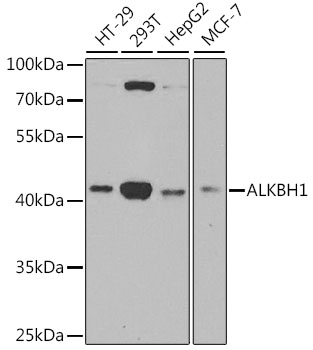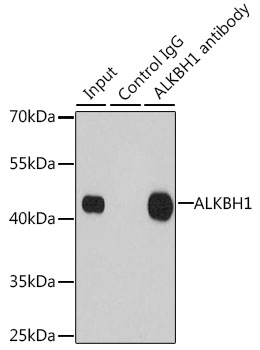-
Product Name
ALKBH1 Polyclonal Antibody
- Documents
-
Description
Polyclonal antibody to ALKBH1
-
Tested applications
WB, IP
-
Species reactivity
Human
-
Alternative names
ALKBH1 antibody; ABH antibody; ABH1 antibody; ALKBH antibody; alkB antibody; hABH antibody; nucleic acid dioxygenase ALKBH1 antibody
-
Isotype
Rabbit IgG
-
Preparation
Antigen: Recombinant fusion protein containing a sequence corresponding to amino acids 110-389 of human ALKBH1 (NP_006011.2).
-
Clonality
Polyclonal
-
Formulation
PBS with 0.02% sodium azide, 50% glycerol, pH7.3.
-
Storage instructions
Store at -20℃. Avoid freeze / thaw cycles.
-
Applications
WB 1:500 - 1:2000
IP 1:50 - 1:200 -
Validations

Western blot - ALKBH1 Polyclonal Antibody
Western blot analysis of extracts of various cell lines, using ALKBH1 antibody at 1:1000 dilution.Secondary antibody: HRP Goat Anti-Rabbit IgG (H+L) at 1:10000 dilution.Lysates/proteins: 25ug per lane.Blocking buffer: 3% nonfat dry milk in TBST.Detection: ECL Enhanced Kit .Exposure time: 30s.

Immunoprecipitation - ALKBH1 Polyclonal Antibody
Immunoprecipitation analysis of 200ug extracts of 293T cells using 1ug ALKBH1 antibody . Western blot was performed from the immunoprecipitate using ALKBH1 antibody at a dilition of 1:1000.
-
Background
Dioxygenase that acts as on nucleic acids, such as DNA and tRNA. Requires molecular oxygen, alpha-ketoglutarate and iron. A number of activities have been described for this dioxygenase, but recent results suggest that it mainly acts as on tRNAs and mediates their demethylation or oxidation depending on the context and subcellular compartment. Mainly acts as a tRNA demethylase by removing N(1)-methyladenine from various tRNAs, with a preference for N(1)-methyladenine at position 58 (m1A58) present on a stem loop structure of tRNAs. Acts as a regulator of translation initiation and elongation in response to glucose deprivation: regulates both translation initiation, by mediating demethylation of tRNA(Met), and translation elongation, N(1)-methyladenine-containing tRNAs being preferentially recruited to polysomes to promote translation elongation. In mitochondrion, specifically interacts with mt-tRNA(Met) and mediates oxidation of mt-tRNA(Met) methylated at cytosine(34) to form 5-formylcytosine (f(5)c) at this position. mt-tRNA(Met) containing the f(5)c modification at the wobble position enables recognition of the AUA codon in addition to the AUG codon, expanding codon recognition in mitochondrial translation. Specifically demethylates DNA methylated on the 6th position of adenine (N(6)-methyladenosine) DNA. N(6)-methyladenosine (m6A) DNA is present at some L1 elements in embryonic stem cells and probably promotes their silencing (By similarity). Also able to repair alkylated single-stranded DNA and RNA containing 3-methylcytosine by oxidative demethylation, but with low activity. Also has DNA lyase activity and introduces double-stranded breaks at abasic sites: cleaves both single-stranded DNA and double-stranded DNA at abasic sites, with the greatest activity towards double-stranded DNA with two abasic sites. DNA lyase activity does not require alpha-ketboglutarate and iron and leads to the formation of an irreversible covalent protein-DNA adduct with the 5' DNA product. DNA lyase activity is not required during base excision repair and class switch recombination of the immunoglobulin heavy chain during B lymphocyte activation. May play a role in placental trophoblast lineage differentiation (By similarity).
Related Products / Services
Please note: All products are "FOR RESEARCH USE ONLY AND ARE NOT INTENDED FOR DIAGNOSTIC OR THERAPEUTIC USE"
